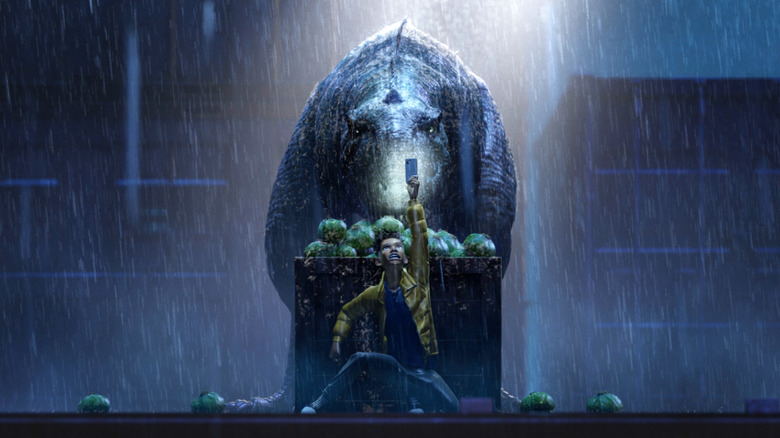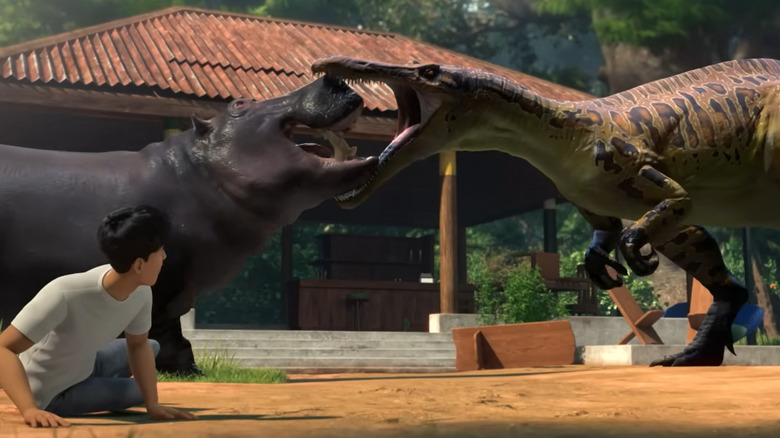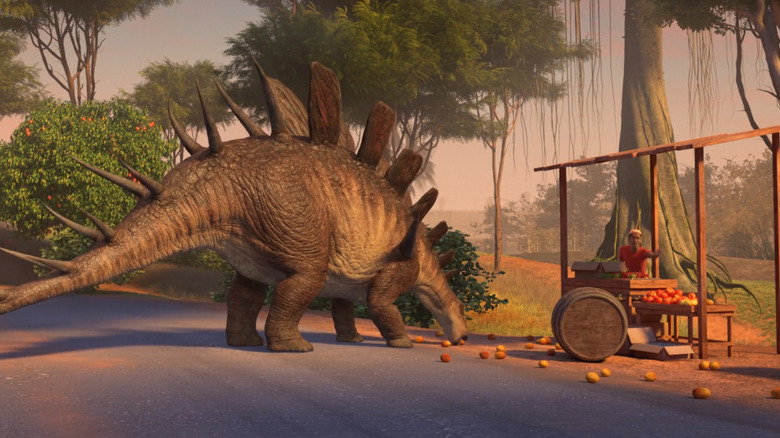Netflix's Jurassic World: Chaos Theory Is Actually Doing The One Thing The Movies Refused To Do
As commercially successful as the "Jurassic World" trilogy was, it was creatively bankrupt. Sure, it had some good ideas, like exploring what would happen if a version of Jurassic Park actually opened to the public (or what if dinosaurs invaded a gothic manor or, even better, the entire continental United States). Be that as it may, those films squandered their coolest elements by going instead with the safest and most boring route at every opportunity — like basically forgetting about the dinosaurs and ending with "Jurassic World Dominion," a movie that focuses on ... prehistoric bugs.
This last bit is important, because the idea of dinosaurs free in the world was without a doubt the best thing the "Jurassic World" movies promised, and we are finally seeing it happen — just not on the big screen. That's because it's the animated series "Jurassic World: Chaos Theory" that's taking up the mantle of delivering on the promise of the movies, which was only briefly hinted at in the "Battle at Big Rock" short film. A sequel to the very underrated and quite good "Jurassic World: Camp Cretaceous," the animated show follows a group of kids who were left behind on Isla Nublar after it was evacuated during the Jurassic World incident. Now, years later, they are investigating a conspiracy involving dinosaur trafficking.
Much like "Camp Cretaceous," "Chaos Theory" improves on the "Jurassic World" films by deepening the ideas and themes, like using the dinosaurs as an allegory for animal rights and preservation, and actually delivering a story that gets scary. Indeed, the best part of "Jurassic World: Chaos Theory" is how it portrays a world where dinosaurs interact with humans and other animals in the wild — and it turns out as badly as you'd predict.
Jurassic World: Chaos Theory lets dinosaurs actually be a part of the world
One of the biggest mistakes the sequel trilogy (except for the second half of "Fallen Kingdom") committed was forgetting that the first "Jurassic Park" is scary as hell. "Chaos Theory," on the other hand, is more grown up and with higher stakes than its predecessor, never shying away from the danger of dinosaurs meeting humans. We constantly see dinosaurs maim and murder people (off-screen, but still), and there are plenty of set pieces that are as nail-bitingly thrilling and scary as those in Steven Spielberg's original classic, like when the first episode of season 2 pits teenagers against dinosaurs on a container ship in the middle of the ocean with no escape (or when a jungle cruise adventure upriver goes wrong and suddenly there are hippos and dinos trying to kill one another).
As showrunner and executive producer Scott Kreamer told IndieWire, "We harken back to the original ['Jurassic Park'] a lot, and that's an all-ages horror movie. It's definitely going to be too scary for some, and we made a lot of people nervous with the line that we were treading when we first started going."
Where "Chaos Theory" season 1 showed the ways having undomesticated animals run wild in the middle of populated areas would result in mayhem, the second season reveals what happens when pre-historic animals meet modern ones. (No surprise, it goes terribly wrong for everyone.) It's a hair-raising sequence when the show's kids, who are navigating a river in Senegal, encounter a hippo who seems hellbent on killing them for no reason (as hippos tend to do). Then, before they can evade it, a suchomimus arrives and starts fighting the hippo. It's like something out of Discovery Channel's "Animal Face-Off," brutal yet as awe-inspiring as the sight of dinosaurs in the very first "Jurassic Park." Most importantly, the sequence fulfills the promise of "Jurassic World: Fallen Kingdom" in showing the consequences of unleashing dinosaurs on humanity.
But before you start thinking dinosaurs can just come in here and obliterate all our mammals, think again — because season 2 also makes it clear an apex predator is an apex predator no matter what era they live in (as seen when a pride of lions devours a dimorphodon).
Jurassic World: Chaos Theory shows dinosaurs as both scary and a nuisance
The way "Chaos Theory" portrays the encounter of two worlds serves two purposes: 1) It helps the show's world come alive, making the dinosaurs that appear more than just window dressing but something that can actually influence and change the world around them, and 2) It makes the franchise's themes of animal preservation and not playing god more poignant by showing you directly why humans and dinosaurs shouldn't co-exist (because it leads to, well, chaos). In the first season, for example, we see a roadside "petting zoo" with kidnapped baby dinos, while season 2 being set in Senegal quite directly draws a line between dinosaur poaching and the poaching of real animals in our world.
"Chaos Theory" depicts this encounter of worlds not just with big set pieces (like having deadly predators capable of just attacking the suburbs), but also by showing a stegosaurus simply blocking traffic because it wants the oranges from a nearby seller (or a compsognathus fighting over food in the middle of the road). We also see how dinosaurs being out in the open affects people psychologically, as seen in the first season when we are introduced to a community undergoing "dino immersion therapy" to face their fear of the living, breathing creatures.
With the next "Jurassic Park/World" movie, "Jurassic World Rebirth," set to once again follow a small group of people yet again trapped on an island, at least we know the franchise has dared to explore something new and exciting at least once, and it was great.
"Jurassic World: Chaos Theory" is now streaming on Netflix.


